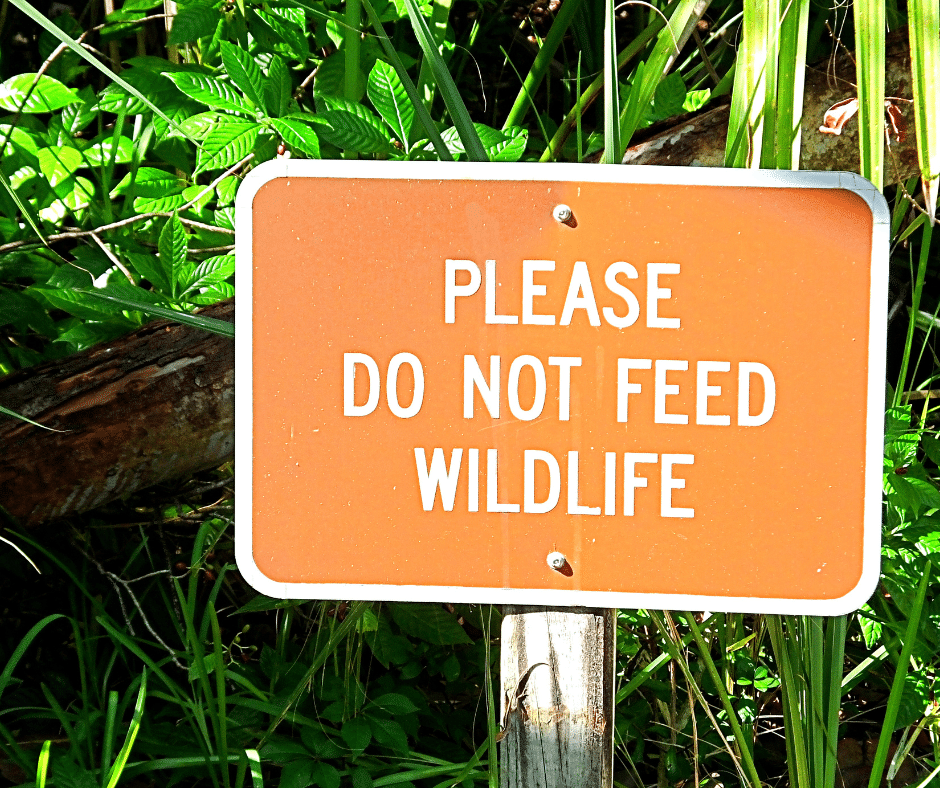
Feeding wildlife during the colder months may seem like a kind and helpful act, but it often does more harm than good—for both animals and humans. Here are six scientifically backed reasons why feeding wildlife this winter is not recommended.
1. Human Food Is Harmful to Animals
Wild animals are adapted to specific diets found in their natural habitats. Human food is not only nutritionally inadequate but can also be toxic to them. Here’s why:
- Nutritional Deficiency: Even if animals eat large quantities of human food, they may still become malnourished because it lacks the nutrients they need to thrive.
- Dependency: Regular feeding can make wildlife reliant on humans and reduce their natural foraging instincts. If feeding stops, these animals may struggle to find food on their own, increasing their risk of starvation.
2. Risk of Disease Transmission
Feeding wildlife increases their proximity to humans, which raises the risk of disease transmission. Wild animals often carry diseases that can be dangerous to both people and pets. Common concerns include:
- Pathogens in Droppings: Diseases such as raccoon roundworm, hantavirus, leptospirosis, histoplasmosis, and salmonellosis are spread through animal feces.
- Rabies Risk: Close contact with wildlife increases the chance of rabies exposure, particularly from animals like raccoons, skunks, and foxes.
To protect yourself and your pets, avoid encouraging wildlife to frequent your yard.
3. Potential Risks to Pets
Feeding wildlife can inadvertently put your pets in harm’s way:
- Injuries from Wild Animals: Curious pets, especially dogs and cats, may approach wild animals and provoke defensive attacks, leading to bites or scratches.
- Attraction of Predators: Food left out for wildlife can attract larger predators like coyotes and foxes, which pose a direct threat to outdoor cats, small dogs, and backyard chickens.
4. Property Damage
Wild animals lured by food may take up residence in or around your home, causing significant damage:
- Structural Issues: Animals like squirrels or raccoons can chew through roofing materials, insulation, and wires, compromising your home’s safety.
- Contamination: Wildlife droppings can stain surfaces, contaminate stored items, and create health hazards.
- Burrows: Species like groundhogs or chipmunks may dig burrows that destabilize foundations, decks, or garden beds.
5. Aggressive Behavior
Feeding wildlife can alter their natural behavior, making them less afraid of humans. This can lead to problems such as:
- Loss of Fear: Animals accustomed to being fed by humans may beg, approach people aggressively, or attempt to steal food.
- Increased Conflict: Animals that are no longer wary of humans may bite or attack when food is not offered, often leading to their removal or euthanasia for public safety.
6. Unwanted Pests
The food you put out may not only attract wildlife but also unwelcome pests:
- Rodents: Mice, rats, and other pests can be drawn to leftover food, which increases the likelihood of infestations in and around your home.
- Invasive Species: Non-native animals that thrive on human food can outcompete local wildlife, disrupting ecosystems.
How to Enjoy Wildlife Responsibly
If you appreciate the presence of wildlife in your neighborhood, there are safer, more sustainable ways to observe and coexist with them:
- Watch from a Distance: Observe animals in their natural habitat without interfering. Use binoculars or the zoom lens on your camera for a closer look.
- Install a Trail Camera: A trail cam lets you monitor and enjoy wildlife activity without direct interaction.
- Avoid Feeding or Touching: Resist the urge to feed or handle wild animals, as this can harm both them and you.
- Manage Food and Garbage Properly: Store food securely and keep trash bins sealed to avoid attracting animals.
- Maintain Clean Bird Feeders: Regularly clean up spilled seed to prevent attracting unwanted pests like rodents.
Wildlife plays a vital role in our ecosystems, and their survival depends on maintaining natural behaviors. By avoiding direct feeding, you help ensure they remain healthy, self-sufficient, and safe from human-related risks.
